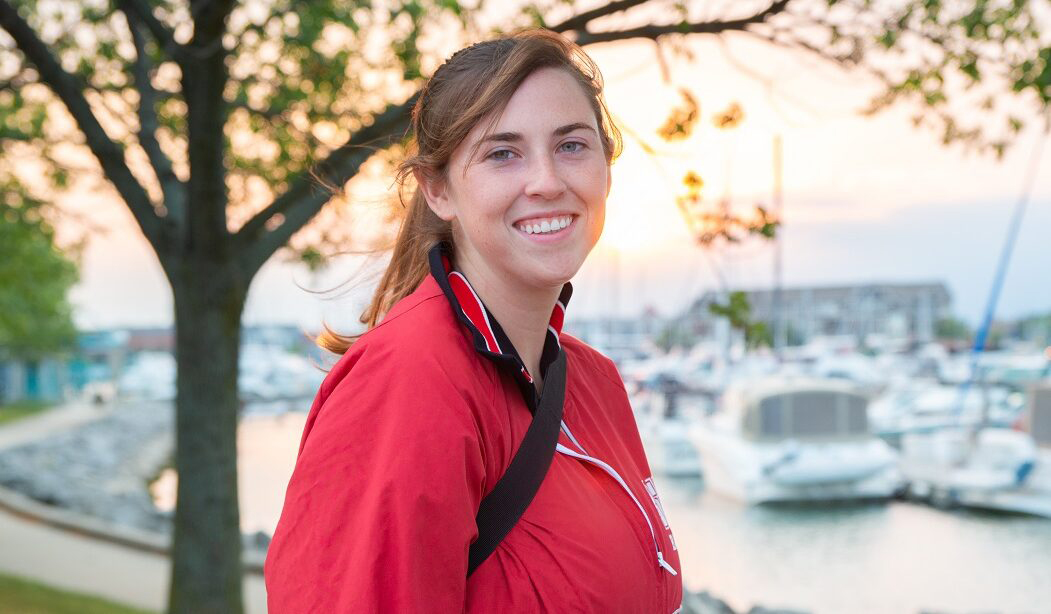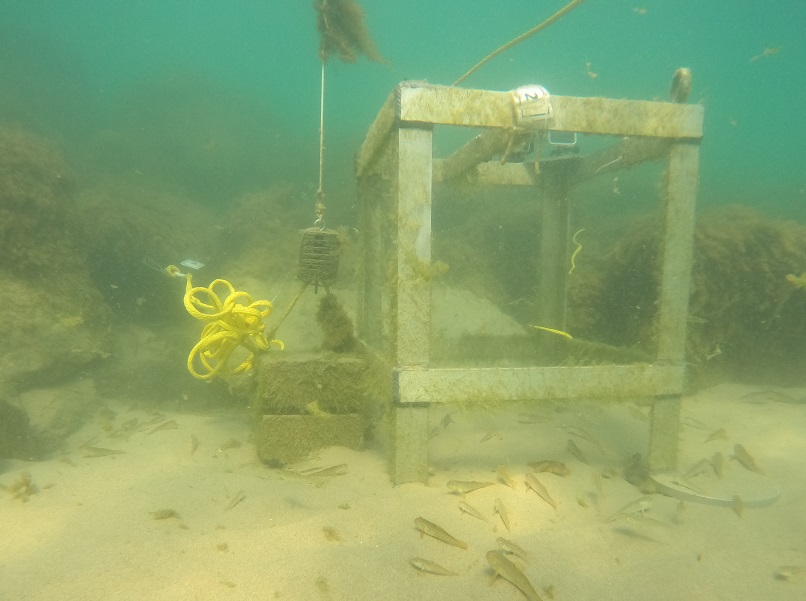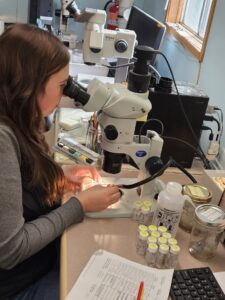
Meet Our Grad Student Scholars is a series from Illinois-Indiana Sea Grant (IISG) celebrating the students and research funded by our scholars program. To learn more about our faculty and graduate student funding opportunities, visit Fellowships & Scholarships.
Amber Schmidt is a second-year graduate student in the Natural Resources and Environmental Science Program at the University of Illinois Urbana-Champaign. Her research is focused on observing the development of benthic invertebrate communities on a nearshore, dynamic reef system in Lake Michigan. She hopes to connect the impacts of geological changes at the reef site to the changes in the benthic community.
The Adeline J. Geo-Karis Illinois Beach State Park, home to over 650 species of plants and animals, contains the last natural shoreline of Lake Michigan and the only area of beach ridge complex in Illinois. In 2021, an artificial reef composed of three submerged breakwaters, nicknamed the “rubble ridges,” was built as a pilot project to repair the shoreline and help prevent further erosion damage in a more natural way. The design, construction, and monitoring of the structure was funded by the Great Lakes Restoration Initiative in partnership with Healthy Port Futures, the Army Corps of Engineers, and the University of Illinois Prairie Research Institute.
Amber Schmidt is a master’s student working in the Czesny Lab at Lake Michigan Biological Station, a field station in the Prairie Research Institute. She is studying the nearshore macroinvertebrate community at the rubble ridges and comparing the results to the community at a control site located south of the ridges. The goal of this project is to provide a full representation of nearshore, benthic community changes and the geological factors that influence them when an artificial reef is introduced into a system.
Benthic invertebrates are organisms without a backbone that live in vegetation or in substrate in a body of water. Benthic invertebrates can indicate the health of a water body and are a significant food source to many organisms throughout the Lake Michigan food web including yellow perch and lake trout, both popular native sportfish.
The rubble ridges are unique due to the design, location, and natural materials used to build the reef. They consist of three ridges comprised of 2−3-ton limestone boulders piled on top of each other. Due to the high energy in this system such as wave action, storm events and currents, the ridges are expected to accumulate sand and flatten over time. This system is located close to the shoreline (approximately 300 feet offshore and 8−12 feet deep) which provides a new, unique habitat in this part of Lake Michigan, providing an extraordinary opportunity to collect both geological and biological data and observe how these two disciplines intertwine at a natural reef system.

The underwater setup of the Hester-Dendy sampler (left), camera frame (right), and minnow trap baited to capture round goby (back left).
To gather samples for this project, benthic cores, sediment cores, round goby (Neogobius melanostomus) abundance estimates, and round goby stomach content were collected at the rubble ridges site and the control site via a combination of boat-based work and SCUBA surveys. Hester-Dendy samplers were only used at the rubble ridges site. These samplers provide surface areas similar to the boulders at the rubble ridges, which allows for the sampling of encrusting invertebrates. There is no such structure at the control site, so Hester-Dendy samplers were not implemented there.
Benthic cores are collected by a SCUBA diver plunging a 3-inch core into the sand and capping it to capture the sediment. Benthic cores are collected to sample the organisms living in the sediment, while sediment cores are collected to quantify the size distribution of the sediment itself. Round goby are known to consume benthic invertebrates and are highly abundant in the rubble ridges. Round goby were sampled using minnow traps set in the ridges, and micromesh gillnets were used outside of the ridges and at the control site. These round goby were sampled to observe the invertebrates in their stomachs because the invertebrates were likely in the sediment at the two sites or encrusted on the boulders at the rubble ridges site.
Pictures were captured every 5 minutes by GoPro’s mounted on camera frames that remained in the water for 2−3 hours per sampling day to estimate goby abundance at the rubble ridges and control sites.
Scuba diving is the only means of sampling in this high energy, shallow environment; thus, safety concerns, the possibility of ice, and low temperatures makes the sampling for this study difficult. The sampling window each year for this project is brief, it occurred monthly from June through September in 2022 and 2023. Schmidt’s project is part of a 5-year monitoring effort of these structures undertaken by the Lake Michigan Biological Station and Illinois State Geological Survey, and sample collection will continue after she is finished with her master’s project.

Amber Schmidt picking through a Hester-Dendy scrape sample under a microscope. Each vial represents a different taxon of benthic invertebrate.
“I worked as a technician at the Lake Michigan Biological Station when this project began in 2021. I fell in love with the project and asked if I could continue the work on the benthic invertebrate side of the study as a graduate student,” Schmidt said. “This research is helping us understand the impacts of structure introduction on Lake Michigan. Many organizations are thinking about placing similar structures in southern Lake Michigan. This project helps us to better understand the effect these structures on the benthic invertebrate communities and food webs as a whole.”

